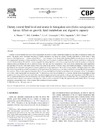Please use this identifier to cite or link to this item:
https://accedacris.ulpgc.es/handle/10553/806
| Title: | Dietary neutral lipid level and source in Senegalese sole (Solea senegalensis) larvae: effect on growth, lipid metabolism and digestive capacity | Authors: | Morais, Silvia Caballero, M. J. Conceição, Luis Izquierdo, M. S. Dinis, Maria Teresa |
UNESCO Clasification: | Investigación | Keywords: | Triacylglycerol level Artemia enrichment Lipid absorption Lipid vacuoles Enterocytes, et al |
Issue Date: | 2006 | Project: | DIVERAQUA / SP5.E36 (Programa INTERREG III A, FEDER) | Journal: | Comparative Biochemistry and Physiology - B Biochemistry and Molecular Biology | Abstract: | Contrary to larval essential fatty acid (EFA) requirements, the effect of dietary neutral lipid supply has been little investigated in marine fish larvae. The present work investigates the effect of feeding Senegalese sole larvae on Artemia enriched with higher or lower doses of lipid emulsion. Two lipid sources — soybean oil and fish oil — were compared. From 16 days after hatching (DAH) onwards, larvae were fed one of four experimental treatments: Artemia enriched on a high or low dose of soybean oil emulsion (HS and LS) or Artemia enriched on a high or low dose of fish oil emulsion (HF and LF). In terms of growth, the dietary lipid level did not have a significant effect while the soybean oil treatments induced a lower growth than the fish oil-enriched Artemia. The fatty acid (FA) composition of the larvae closely reflected the dietary quantitative and qualitative FA profile. Only slight dietary effects were noted in the activity of trypsin, lipase and alkaline phosphatase. A higher amount of lipid droplets was noticeable in the posterior intestine epithelia and in the hepatocytes of larvae fed Artemia enriched with higher lipid doses, while LS-Artemia induced the lower lipid accumulation on the basal zone of the enterocytes, in accordance with the lowest total lipid level measured in this treatment. These results suggest an important effect of dietary total lipid level on lipid accumulation in the enterocytes and on FA absorption. At 33 DAH a tube feeding trial was conducted with 14C-labelled oleic acid (OA) or triolein (TRI), showing that the lower accumulation of lipid droplets in the larvae fed LS was associated with a significantly higher absorption and retention in the gut and body tissues of the TRI label. For OA no significant differences between treatments were found. TRI label was considerably more evacuated than OA, indicating that sole larvae may have a lower capacity to incorporate a triacylglycerol, which needs to be digested. Finally, OA appears to be preferentially utilized for energy production, accumulating more in larval tissues when absorbed in higher amounts. | URI: | https://accedacris.ulpgc.es/handle/10553/806 | ISSN: | 1096-4959 | DOI: | 10.1016/j.cbpb.2006.01.015 | Source: | Comparative Biochemistry and Physiology - B Biochemistry and Molecular Biology [ISSN 1096-4959], v. 144 (1), p. 57-69 |
| Appears in Collections: | Artículos |
SCOPUSTM
Citations
51
checked on Jun 8, 2025
WEB OF SCIENCETM
Citations
49
checked on Jun 8, 2025
Page view(s)
161
checked on Dec 14, 2024
Download(s)
404
checked on Dec 14, 2024
Google ScholarTM
Check
Altmetric
Share
Export metadata
Items in accedaCRIS are protected by copyright, with all rights reserved, unless otherwise indicated.
